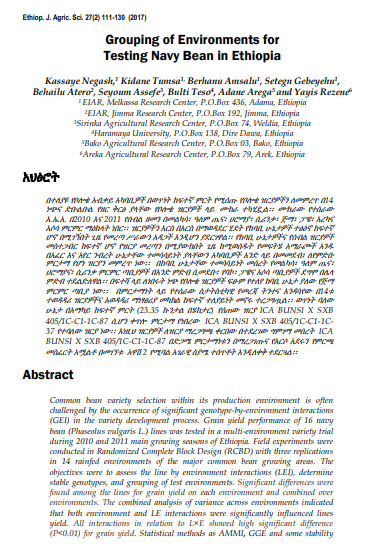Grouping of Environments for Testing Navy Bean in Ethiopia
Summary
Common bean variety selection within its production environment is often challenged by the occurrence of significant genotype-by-environment interactions (GEI) in the variety development process. Grain yield performance of 16 navy bean (Phaseolus vulgaris L.) lines was tested in a multi-environment variety trial during the main growing seasons of Ethiopia in 2010 and 2011. Field experiments were conducted in Randomized Complete Block Design (RCBD) with 3 replications in 14 rainfed environments of the major common bean growing areas. The objectives were to assess the line-by-environment interactions (LEI), determine stable genotypes, and grouping of test environments. Significant differences were found among the lines for grain yield on each environment and combined over environments. The combined analysis of variance across environments indicated that both environment and LE interactions were significantly influenced by lines yield. All interactions in relation to L×E showed high significant difference (P<0.01) for grain yield. Statistical methods such as AMMI, GGE, and some stability parameters were used to describe the LE interaction and to define stable lines in relation to their yield. The highest yield (2435 kg ha-1) was obtained from the line ICA BUNSI X SXB 405/1C-C1-1C-87. The stability analysis also identified lines ICA BUNSI X SXB 405/1C-C1-1C-87 and ICA BUNSI X SXB 405/1C-C1-1C- 37 as the most stable lines. Lines identified as superior differed significantly from the standard varieties and can be recommended for use by farmers in the bean-growing areas of Ethiopia. Cluster analysis, based on grouping of locations, showed Melkassa, Alemtena, and Haramaya as potentially high yielding, but Jimma, Bako, Pawe, Areka, Assosa, and Sirinka as low- to medium-yielding locations.
Open resource Download resource Access resource on external site

